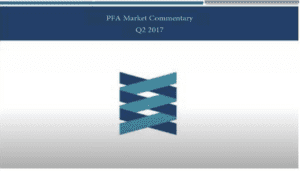Market Commentary – Q2 2017
 Quarterly Recap:
Quarterly Recap:
Second quarter returns on major US stock indices were not as strong as the first quarter with the S&P 500 returning 3.1%, the Nasdaq Composite returning 3.9%, and the Dow Jones Industrial Average returning 3.3%. First quarter financial results released during the second quarter showed strong corporate earnings results, with earnings among S&P 500 companies reaching their highest point in six years. Financial results for the second quarter, as they become available in the coming weeks, will reveal whether corporate earnings growth has slowed in tandem with index results.
Within the S&P 500, which is made up of large US companies, Health Care was the highest performing industry, rising 7.1% over the quarter. Industrials, Financials, and Technology gained 4.7%, 4.2%, and 4.1% respectively. Telecom and Energy were the lowest performing industries, returning -7% and -6.4%.[i] While some analysts indicate that energy companies will lead the S&P 500 in growth in the second half, others warn that declining oil prices could affect growth expectations.
Internationally, all major stock indexes rose around the world, except for four major indices in China, Russia, Israel, and Canada. Declining oil prices and reversion from previous rallies likely contributed to declines in those countries. In addition, increasing exports and a narrowing trade deficit in the US since the beginning of the year coupled with slight losses in the strength of the dollar, which has been strengthening since 2014, point to improving international economies.
In economic news, the Fed raised rates again in June to a target of 1 – 1.25%, the third consecutive quarterly increase. The Fed also unveiled plans to begin decreasing their balance sheet of over $4 trillion in assets, the majority of which were purchased following the recession to stimulate the economy. A portion of the proceeds from maturing government bonds and mortgage debt will cease to be reinvested in similar securities, leading to a gradual decline in Fed balance sheet assets. In addition, another rate hike is likely on the horizon, further indicating a reversal from the non-conventional monetary policies undertaken following the events of 2008.[ii]
Plans to further increase rates and decrease balance sheet assets could be delayed if inflation fails to pick up. After hovering around target levels through the start of the year, inflation fell unexpectedly in May.[iii] The Fed has called the low inflation levels “transitory” and expressed expectations that inflation will rise in the coming months. The most recent jobs report, however, has some analysts arguing that the low inflation levels are more than transitory. While the US added 222,000 new jobs in June, wage growth, which is often cited as an indicator of inflation, is slowing. [iv] If inflation fails to rise, another rate hike could prove shocking for the economy.
Looking Ahead:
With the US stock market reaching its eighth year of expansion, we are seeing less room for growth in domestic stocks over the next few years. While the US economy is still strong, growth rates have started to decline and domestic stock valuations are higher than average. Recent consumer sentiment metrics have shown positive sentiment towards current economic conditions, but increased uncertainty about the future. Increased savings rates further indicate investor uncertainty moving forward. As we head into the second half of the year, we will be monitoring economic indicators for any additional signs of volatility ahead.
Internationally, economies that have lagged in recent years, particularly in Europe, are poised for accelerated growth in the coming years with corporate earnings showing signs of picking up overseas. In addition, the strengthening US dollar over the last few years makes international currency exposure more attractive. In response to these conditions, we have increased our international equity exposure to capture growth in foreign markets.
Interest rates have been at record lows over the last few years, making it difficult to earn competitive yields on fixed income securities. Should the Fed stay the course and continue to increase rates, yields on fixed income securities can be expected to slowly increase. In the meantime, we are seeing the greatest opportunity to earn return in the lower rated “high yield” space. Municipal bonds have also offered competitive yields relative to corporate bonds recently, in addition to their potential tax advantages. However, with some municipalities facing fiscal challenges, we are approaching these opportunities with caution to avoid undue exposure to default risk. Overall, diversification across the credit quality spectrum will continue to be our focus as we manage both interest rate risk and default risk in our fixed income portfolios.
[i] Morningstar Direct
[ii] The Federal Reserve, “Minutes of the Federal Open Market Committee”, June 13 -14, 2017, https://www.federalreserve.gov/monetarypolicy/files/fomcminutes20170614.pdf
[iii] Bureau of Labor Statistics, “Consumer Price Index”, June 2017, https://www.bls.gov/cpi/#tables
[iv] Bureau of Labor Statistics, “Employment Situation News Release”, July 7th, 2017, https://www.bls.gov/news.release/empsit.htm



